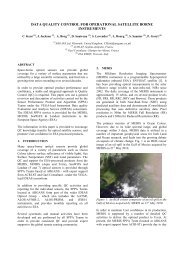SMOS L2 OS ATBD - ARGANS
SMOS L2 OS ATBD - ARGANS
SMOS L2 OS ATBD - ARGANS
Create successful ePaper yourself
Turn your PDF publications into a flip-book with our unique Google optimized e-Paper software.
4.13. Sum of contributions<br />
167<br />
ICM-CSIC<br />
LOCEAN/SA/CETP<br />
IFREMER<br />
4.13.1. Theoretical description<br />
4.13.1.1. Physics of the problem<br />
<strong>SM<strong>OS</strong></strong> <strong>L2</strong> <strong>OS</strong><br />
Algorithm Theoretical<br />
Baseline Document<br />
Doc: SO-TN-ARG-GS-0007<br />
Issue: 3 Rev: 9<br />
Date: 25 January 2013<br />
Page: 167<br />
This module consists in the addition of all the sub-models used to compute the brightness<br />
temperature of a specific ocean grid point at antenna level. Then it includes the forward<br />
model for L-band emissivity of a flat sea, plus correction for surface roughness (3 different<br />
options are considered by now, that can incorporate additional terms for foam, swell effects<br />
or others), the introduction of galactic noise contamination, atmospheric effects, and finally<br />
transport from ground level to antenna level. With the present development, measurements<br />
affected by sun glint and moon contamination are flagged and discarded for retrieval.<br />
However, if in the future algorithms to adequately correct for these effects can be obtained,<br />
the measurements will be kept and the corresponding corrections will be introduced in the<br />
sum of contributions.<br />
The input to module 13 are the equations provided by modules 1 to 12 and will be applied to<br />
those grid points that have been selected as adequate for SSS retrieval in the Measurement<br />
discrimination step.<br />
4.13.1.1.1. Note on first Stokes parameter computation<br />
As information to the rest of modules, we indicate here the detail of the first Stokes parameter<br />
(I=Th+Tv=A1+A2) computation from a complete <strong>SM<strong>OS</strong></strong> measurement (2.4 s), in fact a pair<br />
of two consecutive measurements in orthogonal polarisations:<br />
As A1 and A2 are measured in two consecutive (in case of dual-pol) 1.2 s snapshots, the<br />
incidence angle for a specific grid point is not exactly the same for both, but will differ (in<br />
case of dual-pol) in some 0.6º (approx. 8 km displacement at 756 km height). A little bigger<br />
in case of full-pol.<br />
Then a correction was assumed to be done routinely by shifting both measurements to a value<br />
that corresponds to the angle that is just in the middle of θx and θy (“mean angle”). To do<br />
that, we planned to add to each A the difference between modelled values for the two angles.<br />
However, the modelisation of both polarisations at the antenna reference frame requires<br />
introducing the Faraday rotation angle. And this is the step we want to avoid by computing<br />
the first Stoke parameter. Moreover, this correction would be for sure much below the noise<br />
of the measurement, and then was not expected to have a very significant impact.<br />
Consequently it was decided (October 2006) not to perform any correction to A1 and A2 but<br />
to compute directly a ‘Pseudo’ First Stokes parameter:



